Christopher Columbus was a world-famous explorer and sailor born in 1451 in Genoa, Italy. He was very committed to finding a faster route by sea to Asia. He thought that would be accomplished by sailing across the Atlantic Ocean and heading west. By doing this, he was certain it would make him famous all over the world and seen as a hero. He wanted to become famous, and get wealthy and also saw this as an opportunity to spread Christianity. He never managed to get to Asia, but his many journeys instead led to America, a continent that was not yet discovered. Columbus changed history and his voyages led to something even he couldn’t have imagined.
This article will explore Columbus’s journeys by sea, what he wanted to accomplish in life, and the impact he had on the world, both positive and negative. It will investigate how his findings changed the world completely and led to the colonization of America. Important events such as the Columbian exchange will be brought up and how a continent of native people that lived in peace all of a sudden went into a period of suffering, all because of Columbus’s discovery and how the Europeans were treating them. By understanding Columbus’s story, we can learn more about the beginning of global connections and the mixed legacy he left behind.
Christopher Columbus started to work as a sailor at a young age and became good at making maps and skilled as a navigator. A lot of nations in Europe during this time wanted to find new trading routes, especially with Asia, as a lot of countries were big on the trading market there. A lot of the routes that led through the Middle East were dangerous, so they instead thought it would be better to try routes that led over the sea.1
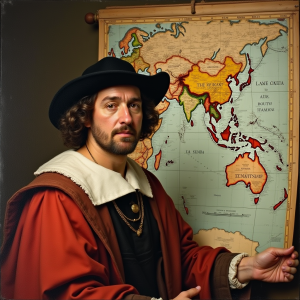
Columbus believed that the fastest way to reach Asia would be to sail across the Atlantic Ocean, heading west. A lot of experts did not agree with his idea and deemed it to be a long and dangerous route and that he was underestimating how big Earth really was. Regardless of all the criticism, Columbus was certain of his idea and wanted to prove everyone wrong.
He still needed the funding though, to be able to make his journey a reality. He reached out to a lot of different monarchs, trying to get the money needed for his voyage, and he was rejected for years, until he finally got an offer from the King and Queen of Spain in 1492. They chose to support his voyage in hopes it would bring them new land, spread their culture, and bring them wealth.
Columbus’s first voyage was set for August 3, 1492. The journey would consist of three ships, the Pinta, the Santa María, and the Niña. There was a lot of uncertainty about what the path through the Atlantic Ocean would look like as it was the first time anyone tried the route. It was a long journey and finally, after about two months, land was spotted on October 12. Columbus thought he had reached Asia. They settled on an island that actually was a part of the Bahamas. He named it San Salvador.2
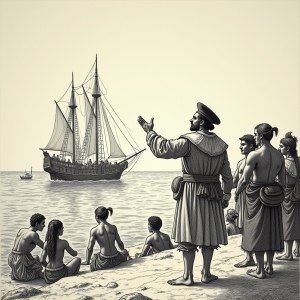
The first people they encountered were the Taino people, native inhabitants of the island. They were described as kind and helpful by Columbus, but he also noted that they did not have much to defend them with. He liked what he saw because it would not be hard to use them as workers and convert them to his own culture and to Christianity. Columbus explored the Caribbean over the next months and returned to Europe in 1493 as a hero. He brought back gold, exotic plants from the island’s nature, and a few of the indigenous people to show the voyage was a massive success.3
Later the same year, Columbus decided to set sail again, and this time with over 1000 men and 17 ships. The first voyage went well and he was encouraged to go back and take advantage of what was discovered. His goal this time was to go back and make the discovered places into colonies. They forced the Taino people into labor, and they were treated very inhumanely. There was a lot of violence and sickness from the Europeans that spread amongst the native people and killed a lot of them. The suffering the indigenous people had to go through during this time was brutal.4
In 1498, Columbus went on his third journey to America. This time he reached the mainland of South America. He acknowledged he had discovered something new, but thought it might be land very close to Asia. He continued with his harsh way of ruling the colonies and eventually the word spread about how he treated the indigenous people. The Spanish Royal family sent people to further investigate the situation and when they arrived they realised quickly that things were not handled correctly. Columbus was arrested and sent back to Spain in cuffs.5
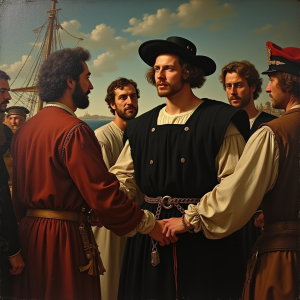
Attribution: Generated by CG Dream
Despite his big failure during his last trip and how he managed the colonies in a violent and inhuman way, Columbus still managed to convince the Spanish crown to give him another chance. They funded his last voyage. This time, he would focus on finding a route from his newly discovered continent to Asia. He never succeeded, and instead had violent encounters, and sickness and returned back to Spain with nothing at all. His last voyage was a huge failure and he spent the rest of his days living in obscurity.6
The fact that Columbus never reached Asia but instead discovered a completely new continent was the start of a very dark time for the indigenous people and the adversity they had to go through is something we still look back at today. The discovery was a very big deal in Europe on the other hand and widely celebrated. While Spain and a big part of Europe gained wealth, recognition, and more land they could use, this was also the beginning of genocide. Columbus’ very harsh and unfair way of ruling the colonies, combined with diseases like smallpox that the Europeans brought, led to the death and suffering of a lot of tribes that before the exploration lived in peace. Columbus quickly went from a hero to a villain who had to pay big for his actions once he returned back to Spain. This is just one of many examples in history where a dominant group of people take advantage of an inferior group for their own winning. This important historical event is something we still look back on today and is something we have learned from.7
One of the main events that happened because of Columbus’ journey was the Columbian Exchange. This was a big trade between the Europeans and the native people of the Americas. The Europeans brought crops, like wheat and sugar in exchange for tomatoes and potatoes, for example. The people of the Americas also traded horses and cattle, which really changed the way they worked and their quality of life. This was a very positive interaction between the European settlers and the indigenous people and it looked like it could start something good between the two parts. There were both positives and negatives with the trade, and it was something that shaped the modern world today. That was until a lot of the indigenous people started to get sick. The Europeans had brought sickness with them that wiped out entire tribes.8
European colonization got a huge upswing from Columbus’s voyages. Spain got involved among the first and shortly after followed by a lot of other European nations. Europe claimed large chunks of land in the newly discovered continent. This led to Europeans gaining access to a lot of natural resources that were not available in Europe and they could also easily overwhelm the indigenous people and use them as a workforce. This period shaped the following centuries of colonization, which brought a lot of good to various cultures, but also a lot of suffering.
In the modern world, Columbus is remembered as one of the most influential explorers of all time. The person who explored North and South America, and is seen as someone who changed the world. But he is also seen as very controversial. He opened up a lot of different global opportunities and connections, but he is also the person that is responsible for the suffering of the indigenous people who lived there before Columbus. Therefore, he is also seen as cruel and this brings his achievement down in a lot of people’s eyes. This shows the two sides that exploration and colonization bring and how it is not beneficial for everyone involved.
Christopher Columbus’s story can be summarized as a brave explorer with dreams of becoming famous, getting wealthy, and spreading Christianity, but turned into a villain because of the consequences that come with colonization. He wanted to find a faster route to Asia but ended up discovering a brand new continent for Europe. His voyages sparked global changes, including the Columbian Exchange and European colonization, while also leading to the suffering of indigenous peoples.
Columbus is today both criticized and celebrated because of his findings and actions. He is a very important character and shaped the beginning of global trading and connections. Columbus is also important to understand the many challenges of colonization and why it is so important to examine history from multiple perspectives.
- “Christopher Columbus—Facts, Voyage & Discovery,” History.com, Last modified April 6, 2020. Accessed December 12, 2024. ↵
- Christopher Columbus, “Letter to Luis de Santangel Announcing His Discovery (1493),” in Select Letters of Christopher Columbus, ed. R. H. Major (London: Hakluyt Society, 1847) ↵
- Felipe Fernández-Armesto, Columbus (New York: Oxford University Press, 1991), 34-37. ↵
- Samuel Eliot Morison, Admiral of the Ocean Sea: A Life of Christopher Columbus (Boston: Little, Brown and Company, 1942) ↵
- Encyclopaedia Britannica, “Christopher Columbus,” last modified January 2, 2022 ↵
- World History Encyclopedia, “The Voyages of Columbus,” accessed November 12, 2024. ↵
- David E. Stannard, American Holocaust: Columbus and the Conquest of the New World (New York: Oxford University Press, 1992), 54-58. ↵
- Encyclopaedia Britannica, “Columbian Exchange,” last modified June 15, 2022 ↵
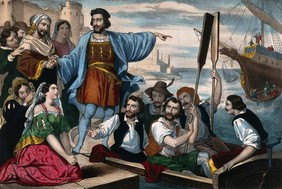
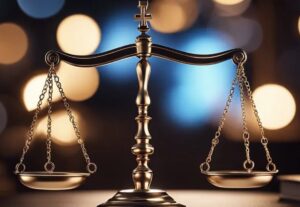
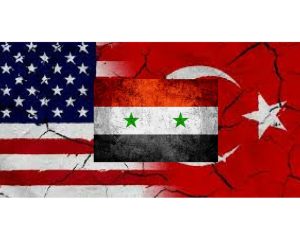
1 comment
Natalia De la garza
Thank you for this excellent piece I loved it! You captured Columbus’s ambitions and the profound impact of his discoveries so well. It’s a thoughtful summary of his legacy, both positive and negative. Great work!